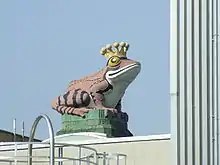Werner & Mertz
Werner & Mertz is a German holding company headquartered in Mainz. It manufactures products in cleaning, care and conservation products for bulk and private consumers. It was established in 1867 as a trading company.

History
On 23 October 1867, Friedrich Christoph Werner and Georg Werner, descendants of Wolfgang Werner, a hunchback of the St. Quintin's Church, Mainz, founded the Werner Brothers waxware factory. In 1878 Georg Mertz, the second namesake, joined the company. Since then, the waxware factory has been trading under the name Werner & Mertz.
In 1887, with the death of Georg Mertz, his brother-in-law, Philipp Adam Schneider, took over his shares and managed the company together with Friedrich Christoph Werner. After a fire in the factory in Mittlere Bleiche 16 in Mainzer Bleichenviertel, a new factory building was moved into in Mainzer Erthalstraße 5 on 30 September 1896. After Philipp Adam Schneider's death on 10 August 1901, his son Rudolf took over the management of the company at the age of 19. From 1903 he managed the company together with his brother Hermann Schneider.
In 1908 a major fire destroyed the factory and residential buildings in Erthalstraße, and in autumn the company moved into its new factory buildings in Ingelheimer Aue. After a fire in 1917, production continued at the same location in the newly built factory in the summer of 1918. The ″Froschturm″, the landmark of the ″Erdal″ in Mainz, was also built at this new site. In 1944, a large-scale attack by allied bomber units destroyed 80 percent of the company buildings, but the frog tower remained intact. On 3 May 1946 Radio Frankfurt announced ″The world-famous Erdal factory is producing again″.
The branch factory in Hallein, Austria, started production at the beginning of 1954. In the same year Rudolf Schneider left the company management. In 1962 Hermann Schneider handed over the management of the company to his son Helmut. The biggest investment in the company's history in 1996 was the construction of a modern logistics centre with a fully automatic high-bay warehouse in Mainz. The new "L8" production centre in Mainz was inaugurated in 2019.
From Helmut Schneider's three children, his son Reinhard finally took over the management of the company in 2000 and in the fifth generation. In September 2010, the head office moved to an ″Energie-Plus-Bilanz-Haus″ on Rheinallee in Mainz.
The invention of shoe polish
At the end of the 19th century, based on its expertise in wax processing, the company developed a novel wax-based shoe polish: the shoe dyes and shine agents previously available, consisting of sulphur, carbon black, syrup, molasses and water, had a rather destructive effect on the leather, adhered less to the shoes and soiled the men's legwear and ladies' skirts.
The development of the shoe care brand Erdal
In order to be able to register the "Stiefelwichse" under trademark law, a suitable name was found - following the street name of the company headquarters - with Erdal. On September 28, 1901, the Erdal trademark was filed with the Berlin Patent Office with the serial number 50 848 on the sign roll. Following the spirit of the times, the brand name was assigned an animal from the fairytale world as an unmistakable symbol in 1903. The frog - an animal living in and around the water that looks at the world from the frog's perspective - seemed to be suitable for depicting the properties of the novel shoe care product. Until the First World War, the logo appeared in the form of a green frog on the packaging specially developed for the shoe care product, a handy tin can.
From a trading company to a branded goods company
Products of Werner & Mertz: brands Erdal, Frosch and ratz fatz
Between 1912 and 1939 the company grew steadily through new shoe care products, expansion of distribution and logistics as well as advertising and sales promotion. In 1921 Erdal was the best-selling shoe care product in Germany. At that time, the company had an estimated 1,200 employees. In 1928, the Berlin company Urban & Lemm, which produced the successful shoe polish Urbin, was acquired. In 1939, the workforce grew to around 1,800 employees. After 1945, the company increased its sales with new products. From 1946 to 1949 Paul Harnischmacher was president of the Chamber of Industry and Commerce for Rheinhessen.
Tana Chemie GmbH was founded in 1971 to supply large-scale consumers such as restaurants, hospitals, industrial plants and office buildings, Werner & Mertz Polska in 1999 and Werner & Mertz Slovakia and the Czech Republic in 2001.
In 1986 the Frosch brand was introduced - with phosphate-free household cleaners: Neutral and vinegar cleaners. In the meantime, the ecologically positioned range comprises more than 50 products. Since 1996, the Erdal shoe care range has been solvent-free; since 2009, emsal products contain ingredients on a natural basis. In 2008, the company's annual sales amounted to 284 million euros, in 2012 to 305 million euros, and in 2015 to 340 million euros.
Brands

- Erdal : Shoe polish produced and marketed since 1901.
- Frosch (frog): Environment friendly cleaning chemicals produced since 1986.[1] The brand is also known as Rainett in France based on the "Rainette" frog species in French.[2]
- Tana : Cleaning textiles
References
- "About Us". Retrieved 2016-05-03.
- Rainett
